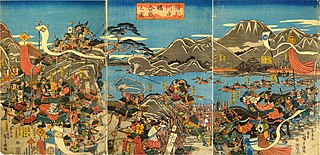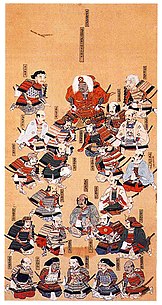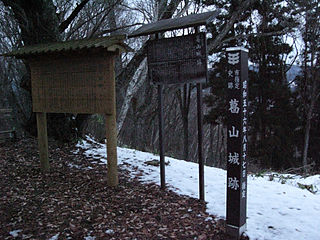Ogasawara Nagatoki(小笠原長時) (November 9, 1519 – April 17, 1583) was a Japanese samurai daimyō of Shinano Province in the Sengoku period. [1]

Japan is an island country in East Asia. Located in the Pacific Ocean, it lies off the eastern coast of the Asian continent and stretches from the Sea of Okhotsk in the north to the East China Sea and the Philippine Sea in the south.
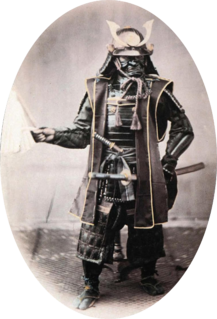
Samurai (侍) were the military nobility and officer caste of medieval and early-modern Japan.

The daimyō were powerful Japanese feudal lords who, until their decline in the early Meiji period, ruled most of Japan from their vast, hereditary land holdings. In the term, dai (大) means "large", and myō stands for myōden(名田), meaning private land.
In 1542, Shinano Province was invaded by Takeda Shingen, and Ogasawara allied with Murakami Yoshikiyo, Suwa Yorishige, and Kiso Yoshiyasu in an attempt to stop him. They met Takeda Shingen's forces at the Battle of Sezawa on 9 March 1542, and were defeated. [2]
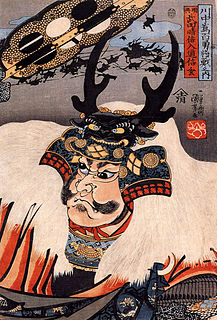
Takeda Shingen, of Kai Province, was a pre-eminent daimyō in feudal Japan with exceptional military prestige in the late stage of the Sengoku period.

Murakami Yoshikiyo was a Japanese samurai from the Murakami clan and retainer of the Uesugi clan during the Sengoku period of the 16th century. Yoshikiyo followed in fighting against both Takeda Nobutora and his son Takeda Shingen. Yoshikiyo was also a very close ally under Uesugi Kenshin and one of Shingen's bitterest opponents for his high kill-counts in their conflicts.
Suwa Yorishige (諏訪頼重) (1516–1544) was a Japanese samurai and head of the Suwa clan. He was defeated by Takeda Shingen, and his daughter Suwa Goryōnin was taken as Shingen's concubine. She later gave birth to the Takeda clan heir Takeda Katsuyori.
Following this defeat, and the conquest of his lands, Ogasawara allied himself with Uesugi Kenshin, Takeda's primary rival. He fought alongside Takatō Yoritsugu in 1545, ultimately failing in their defense against the first siege of Takatō Castle. Ogasawara was defeated by Shingen again several years later, in the 1548 Battle of Shiojiritoge, in which he was hit by a surprise attack at dawn; many of his men were killed as they reached for weapons and armor. His losing streak continued the following year, when Shingen seized a number of fortresses, including Fukashi (now Matsumoto Castle), in the Siege of Fukashi. [2]
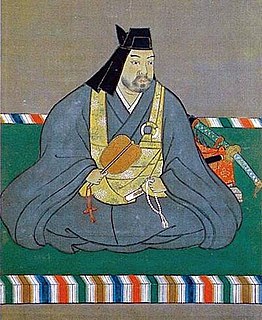
Uesugi Kenshin was a daimyō who was born as Nagao Kagetora, and after the adoption into the Uesugi clan, ruled Echigo Province in the Sengoku period of Japan. He was one of the most powerful daimyōs of the Sengoku period. While chiefly remembered for his prowess on the battlefield, Kenshin is also regarded as an extremely skillful administrator who fostered the growth of local industries and trade; his rule saw a marked rise in the standard of living of Echigo.
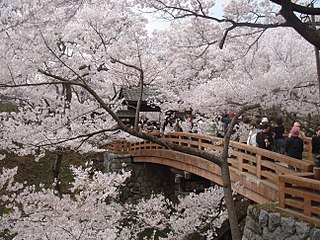
The 1545 siege of Takatō castle marked the first time Takatō had been besieged. Takeda Shingen, continuing his sweep through the Ima Valley of Shinano Province, seeking to take control of the entire province, defeated Takatō Yoritsugu, the castellan. Takatō had relied on support from his allies, Ogasawara Nagatoki and Tozawa Yorichika, who failed to aid in his defense.
The 1548 battle of Shiojiritoge was one of many battles fought by Takeda Shingen in his bid to conquer Japan's Shinano Province. It took place soon after Shingen suffered a devastating loss in the battle of Uedahara; he sought revenge, and to return to a string of victories.
This final, bitter loss caused Ogasawara Nagatoki to retreat to Kyoto, where he taught horsemanship and archery ( Kyūdō ) until his murder in 1583. Some of his descendants became daimyo in the Edo period, most notably as rulers of the Kokura Domain.[ citation needed ]

Kyoto, officially Kyoto City, is the capital city of Kyoto Prefecture, located in the Kansai region of Japan. It is best known in Japanese history for being the former Imperial capital of Japan for more than one thousand years, as well as a major part of the Kyoto-Osaka-Kobe metropolitan area.
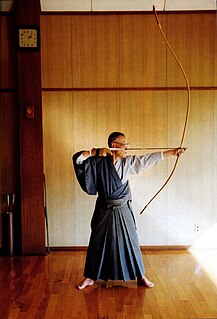
Kyūdō (弓道) is the Japanese martial art of archery. Experts in kyūdō are referred to as kyūdōka (弓道家). Kyūdō is based on kyūjutsu, which originated with the samurai class of feudal Japan. Kyūdō is practised by thousands of people worldwide. As of 2005, the International Kyudo Federation had 132,760 graded members.
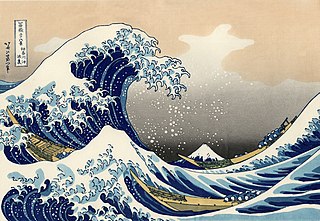
The Edo period or Tokugawa period (徳川時代) is the period between 1603 and 1868 in the history of Japan, when Japanese society was under the rule of the Tokugawa shogunate and the country's 300 regional daimyō. The period was characterized by economic growth, strict social order, isolationist foreign policies, a stable population, "no more wars", and popular enjoyment of arts and culture. The shogunate was officially established in Edo on March 24, 1603, by Tokugawa Ieyasu. The period came to an end with the Meiji Restoration on May 3, 1868, after the fall of Edo.

